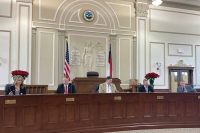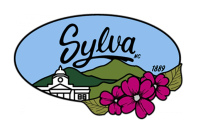Sochan in springtime: Cherokee looks to reclaim plant gathering traditions in the Smokies
For centuries and even millennia, the early spring greens of the sochan plant have served as a celebration of spring for the Cherokee people. If a proposal now out for public comment meets approval, in a few months tribal members could hold that celebration with greens harvested in the Great Smoky Mountains National Park.
“Our culture is not linear. It’s more circular, and going back to places like the park, to where we once inhabited and lived and collected, it takes on a different meaning of spirituality,” said Tommy Cabe, forest resource specialist for the Eastern Band of Cherokee Indians and a sochan gatherer himself. “It takes on a different meaning of who we are as Cherokee.”
Monteith remembered as man of the people
When speaking to the many people in Swain County and beyond who knew David Monteith either personally or professionally, they all used the same word to describe him — integrity.
Symbols matter, and so does removing them
 Complicated. Ignorant. Entrenched. It’s easy to come up with words to describe the state of race relations in this country and especially in the South, but some come to mind more easily than others after what happened in Charleston last week. Dylann Storm Roof attended Bible study with black congregants of Emanuel AME Church in Charleston and then summarily gunned down nine of those in the group.
Complicated. Ignorant. Entrenched. It’s easy to come up with words to describe the state of race relations in this country and especially in the South, but some come to mind more easily than others after what happened in Charleston last week. Dylann Storm Roof attended Bible study with black congregants of Emanuel AME Church in Charleston and then summarily gunned down nine of those in the group.
And once again we in this country are forced to confront the ugly reality of racism, compelled to search for ways to turn tragedy into change.
Over the hills and far away: Folk School bridges the essence of humanity
 Taking a left off U.S. 64 onto Settawig Road in rural Clay County, the busy commercial thoroughfare transforms into lush farmland. The mountain air gets sweeter, soothing late spring sunshine spilling into the open windows of your vehicle.
Taking a left off U.S. 64 onto Settawig Road in rural Clay County, the busy commercial thoroughfare transforms into lush farmland. The mountain air gets sweeter, soothing late spring sunshine spilling into the open windows of your vehicle.
A few miles down the winding road, you enter the tiny community of Brasstown, with its one gas station and handful of buildings. You take another left and cross a bridge into Cherokee County. And though that bridge may just seemingly provide transport over the waters of Brasstown Creek, one will soon understand that the threshold is more than meets the eye.
Working to preserve ‘Cherokee Traditions’
 By Anna Fariello • Guest Editorial
By Anna Fariello • Guest Editorial
In writing the text for an exhibition on Cherokee culture a few years ago, I began with this opening line, “Chances are, where you are standing is part of the Cherokee’s ancestral lands.” While, perhaps, I should have hesitated to make such a bold claim of an exhibit that was traveling throughout Western North Carolina, that statement was far from rash. Today, many think of Cherokee as a town at the entrance to the Great Smoky Mountains National Park, while in fact, Cherokee lands once extended to portions of eight modern states.
When The Smoky Mountain News asked me to write this guest editorial, I was in the midst of putting the finishing touches on a talk for Western Carolina University’s annual Native Expo (9 a.m. to 9 p.m. Nov. 12). The expo takes place every November to celebrate and share native cultures with students and the community. Events include talks, film, language, music, and art that celebrate indigenous culture as the university’s contribution to Native American Heritage Month. This year, among other events, the Hunter Library mounted a tribute to the late Robert J. Conley, a prolific and talented writer who served for three years as the university’s Distinguished Sequoya Professor.
Celebrating this region’s culture part of our identity
 Anyone who reads The Smoky Mountain News regularly knows we emphasize in-depth, investigative stories when that’s what is called for to get to the bottom of something. Everyone at our company takes great pride in that aspect of our identity.
Anyone who reads The Smoky Mountain News regularly knows we emphasize in-depth, investigative stories when that’s what is called for to get to the bottom of something. Everyone at our company takes great pride in that aspect of our identity.
Passing on the song of Appalachia: JAM teaches music, tradition and a sense of place
 At the front of the room, banjos and fiddles plow through an Appalachian repertoire. Fingers dance across strings, conjuring the history and tradition that have seeped out of the region’s hills for generations.
At the front of the room, banjos and fiddles plow through an Appalachian repertoire. Fingers dance across strings, conjuring the history and tradition that have seeped out of the region’s hills for generations.
“Trying to get’em to play together on the same beat at the beginning is kind of like herding cats,” laughed instructor Robby Robertson. “But by the end they get it together.”
Across the audience, parents capture the moment with cell phone cameras. The young musicians focus on their instruments and ready themselves for another song.
A trip back in time: New heritage museum tells the story of Swain’s people, by Swain’s people
 The Smoky Mountain News recently got a sneak peek of the new Swain County Heritage Museum and Visitor’s Center. Leading the tour was David Monteith, who’s been a driving force and visionary behind the museum since its inception.
The Smoky Mountain News recently got a sneak peek of the new Swain County Heritage Museum and Visitor’s Center. Leading the tour was David Monteith, who’s been a driving force and visionary behind the museum since its inception.
A fire that lasts: Cherokee culture grows in new museum director’s life, community
 Give a museum director an open opportunity to tout his facility’s newest this, unique that and state-of-the-art these, and no one could blame him for taking it.
Give a museum director an open opportunity to tout his facility’s newest this, unique that and state-of-the-art these, and no one could blame him for taking it.
But talking with Bo Taylor wasn’t like that. Just named director in November 2013, Taylor’s museum tour started with a walk through the archives. The shelves, motorized to move depending on whether one wants to access aged historical books, newer research, microfilms in a variety of languages or the portrait photographs of past and present Cherokee elders, hold plenty of fascinating items. But they’re not the kind of flashy objects that make for catchy photographs or headlines.
A new paradigm
For decades, mountain tourism strategists have concocted catchy ways to state the obvious: come visit us because we are in the mountains.
It was so predictable. And there were only so many ways you could say it.





